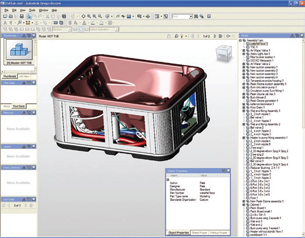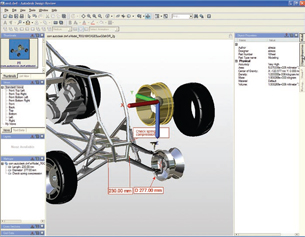December 4, 2001
By David Cohn
 The user interface in Autodesk Design Review 2009 has changed somewhat from earlier versions,with individual palettes that can be docked, undocked, pinned, and grouped. |
In 2007, Autodesk released its Design Review collaboration software as a free application; while at the same time adding a number of new functions and improving many existing features (see October 2007 DE). By doing so, the company enabled anyone to view, measure, mark up, annotate, and print designs saved in the company’s DWF format.
All of Autodesk’s products can publish CAD data as DWF files and marked-up DWF files can be saved from Design Review and sent back to the original MCAD application where the markups can be overlaid on top of the original MCAD file. This capability works with virtually all Autodesk software, including all AutoCAD-based programs as well as Inventor and Revit, eliminating the need for hard copy check prints and greatly improving collaboration workflow. Autodesk also offers a free DWF Writer application to create DWF files from any other Windows application, with special plug-ins that provide enhanced capabilities when publishing DWF files from SolidWorks, Pro/ENGINEER, and CATIA. There are also Design Review plug-ins that add import and publish capabilities for the JT and MicroStation DGN file formats.
Then, in 2008, Design Review offered an improved user interface, persistent 3D measure and markup, improved 3D section functionality, novel 3D navigation and visualization tools, and several new capabilities including DWF version compare, online product search, and geographic reference with live GPS. So, we ask, what’s in store for users in Design Review 2009?
 New pinned palettes collapse and expand similar to AutoCAD. Persistent 3D markup and theability to pull apart 3D models continue from previous versions. |
Well, there aren’t many truly new features in the latest release. That’s not to say there aren’t any changes. The first thing you’ll notice is a new look. Gone are the old-style toolbars that changed depending on whether the sheet being displayed in the Canvas pane (the main viewing area) contained 2D or 3D content. Now, the various tools simply become active or inactive based on the content type. Individual toolbars can be turned on and off, and rearranged, but only within the confines of the toolbar area at the top of the screen.
The Navigator pane along the left side of the interface also has a new look, and is no longer really a pane at all, but rather just one of several areas in which individual palettes can be docked. Each palette — there are now 10 of them, with separate palettes for thumbnails and list views and for sheet, markup, and object properties — can float freely or can be docked around the edges of the canvas. When docked, a palette remains displayed at its current size and can be moved. But palettes can also be pinned, in which case the palette collapses to a small tab when you move your mouse away from it, thus freeing up screen space.
Palettes can also be grouped, so that several palettes occupy the same amount of space on the screen. When grouped, each palette is represented by a tab at the bottom of the group. But it’s far too easy to accidently group palettes and, at resolutions lower than 1280 x 1024, the interface can become quite crowded and confusing. Happily, you can save a palette arrangement as a custom workspace.
Autodesk Design Review 2009 Recommended System Requirements |
The other significant change in Design Review 2009 is the inclusion of support for the DWFx format. All Autodesk products can now save both standard DWF files and the new DWFx format. DWFx is a Microsoft XPS- (XML Paper Specification) compliant variation of DWF. This format is built directly into Windows Vista and can be added to Windows XP via a downloadable component, so that users can view DWFx files directly in Internet Explorer or Windows Explorer without the aid of a separate viewing application. Design Review 2009 also offers a new Find tool to help users quickly search for design content. And the new release performs somewhat faster than its predecessor.
In spite of a lack of new features, I remain quite bullish about DWF in general and Design Review in particular. I can cut days out of project review cycles, save printing and shipping costs, and reduce errors through electronic review. I also love the fact that whenever someone adds a new markup or changes the status of an existing annotation, Design Review records not only the markup itself but also keeps track of who created or changed it, the date and time of the change, the markup status, and any associated notes. I just wish there was a way to easily hide completed markups without deleting them; deleting them removes the extremely valuable electronic paper trail associated with each markup.
Design Review 2009 now ships with the latest versions of most Autodesk products. But since it’s free, anyone can download a copy from the Autodesk website. With all of these great capabilities and an unbeatable price, you owe it to yourself to give Design Review 2009 a try.
More Info:
Autodesk, Inc.
San Rafael,CA
Contributing Editor David Cohn is a computer consultant and technical writer based in Bellingham,WA, and has been benchmarking PCs since 1984. He’s the former Editor-in-Chief of Engineering Automation Report and CADCAMNet, and the author of more than a dozen books. Please send comments about this article to [email protected]. You can also contact David at [email protected].
Subscribe to our FREE magazine, FREE email newsletters or both!
About the Author
David Cohn is a consultant and technical writer based in Bellingham, WA, and has been benchmarking PCs since 1984. He is a Contributing Editor to Digital Engineering, the former senior content manager at 4D Technologies, and the author of more than a dozen books. Email at [email protected] or visit his website at www.dscohn.com.
Follow DE





